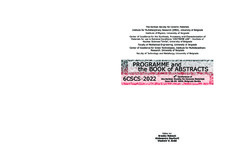Prikaz osnovnih podataka o dokumentu
The defect structure and electrical properties of the spark plasma sintered antimony-doped barium stannate
| dc.creator | Vukašinović, Jelena | |
| dc.creator | Rapljenović, Željko | |
| dc.creator | Počuča-Nešić, Milica | |
| dc.creator | Ivek, Tomislav | |
| dc.creator | Peter, Robert | |
| dc.creator | Branković, Zorica | |
| dc.creator | Zemljak, Olivera | |
| dc.creator | Branković, Goran | |
| dc.date.accessioned | 2023-08-02T06:07:53Z | |
| dc.date.available | 2023-08-02T06:07:53Z | |
| dc.date.issued | 2022 | |
| dc.identifier.isbn | 978-86-80109-23-7 | |
| dc.identifier.uri | http://rimsi.imsi.bg.ac.rs/handle/123456789/2025 | |
| dc.description.abstract | Barium stannate, BaSnO3 (BSO), is a perovskite-type alkaline earth metal stannate with almost ideal cubic structure. Appropriate doping can alter this wide band gap material’s electrical characteristics and change it either into a proton conductor or n-type semiconductor. In the case of Sb doping on Sn site, BSO becomes n-type semiconductor with high electrical conductivity at 25 °C. The major drawback of BSO-based ceramics is its low density. The conventional solid state procedure requires long thermal treatments with several intermittent grinding and heating steps at temperatures up to 1600 °C [1]. To overcome this problem, we used Spark Plasma Sintering technique (SPS) for the preparation of BaSn1-xSbxO3, (x = 0.00 (BSSO0) and 0.08 (BSSO8)) ceramic samples. The samples structural properties were investigated using XRD (X-Ray Powder Diffraction), XPS (X-Ray Photoelectron Spectrophotmetry) and SIMS (Secondary Ion Mass Spectrometry) analyses. XPS analysis revealed the existence of many structural defects, including mixed oxidation states of tin (Sn2+/Sn4+) and oxygen vacancies (VO) in both BSSO samples. The electrical properties of the BSSO ceramic samples were investigated in the temperature range of 4–300 K. The presence of oxygen vacancies in the BSSO0 sample led to the absence of the standard activated semiconductor behavior, showing almost linear temperature-dependent resistivity in the examined temperature range. On the other hand, the BSSO8 sample showed almost temperature-independent resistivity in the range of 70–300 K. This could be a consequence of the presence of many structural defects such as mixed oxidation states of Sn2+/Sn4+, probably Sb3+/Sb5+ and significant amount of O- species, as well as the presence of the low angle grain boundaries found in this sample. The BSSO8 ceramic sample could satisfy the huge demand for the linear resistors with moderate and high conductivity, due to its low and almost constant electrical resistivity in the wide temperature. 1. A.-M. Azad, L.L.W. Shyan, T.Y. Pang, C.H. Nee, Ceram. Int., 26 (2000) 685. | sr |
| dc.language.iso | en | sr |
| dc.publisher | University of Belgrade, Institute for Multidisciplinary Research | sr |
| dc.relation | Ministry of Education, Science and Technological Development, Republic of Serbia, Grant no. 200053 (University of Belgrade, Institute for Multidisciplinary Research) (RS-200053) | sr |
| dc.rights | openAccess | sr |
| dc.rights.uri | https://creativecommons.org/licenses/by-nc-nd/4.0/ | |
| dc.source | 6th Conference of the Serbian Society for Ceramic Materials, 6CSCS-2022, June 28-29, 2022, Belgrade, Serbia | sr |
| dc.subject | BaSnO3 | sr |
| dc.subject | n-type semiconductor | sr |
| dc.subject | XPS | sr |
| dc.subject | Defect structure | sr |
| dc.subject | Temperature-independent resistivity | sr |
| dc.title | The defect structure and electrical properties of the spark plasma sintered antimony-doped barium stannate | sr |
| dc.type | conferenceObject | sr |
| dc.rights.license | BY-NC-ND | sr |
| dc.citation.epage | 76 | |
| dc.citation.spage | 75 | |
| dc.identifier.fulltext | http://rimsi.imsi.bg.ac.rs/bitstream/id/5343/bitstream_5343.pdf | |
| dc.identifier.rcub | https://hdl.handle.net/21.15107/rcub_rimsi_2025 | |
| dc.type.version | publishedVersion | sr |

